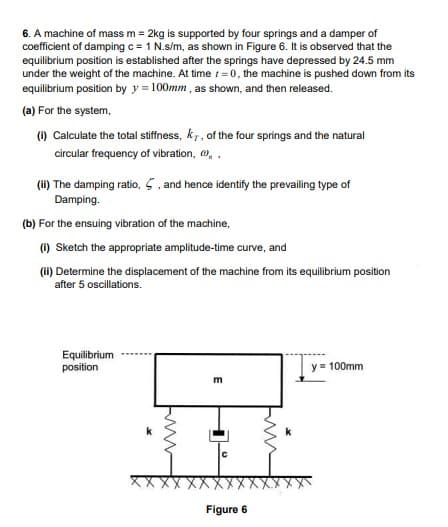6. A machine of mass m = 2kg is supported by four springs and a damper of coefficient of damping c = 1 N.s/m, as shown in Figure 6. It is observed that the equilibrium position is established after the springs have depressed by 24.5 mm under the weight of the machine. At time t=0, the machine is pushed down from its equilibrium position by y = 100mm, as shown, and then released. (a) For the system, () Calculate the total stiffness, kr, of the four springs and the natural circular frequency of vibration, o,, (H) The damping ratio, 5. and hence identify the prevaling type of Damping. (b) For the ensuing vibration of the machine, () Sketch the appropriate amplitude-time curve, and (ii) Determine the displacement of the machine from its equilibrium position after 5 oscillations.
6. A machine of mass m = 2kg is supported by four springs and a damper of coefficient of damping c = 1 N.s/m, as shown in Figure 6. It is observed that the equilibrium position is established after the springs have depressed by 24.5 mm under the weight of the machine. At time t=0, the machine is pushed down from its equilibrium position by y = 100mm, as shown, and then released. (a) For the system, () Calculate the total stiffness, kr, of the four springs and the natural circular frequency of vibration, o,, (H) The damping ratio, 5. and hence identify the prevaling type of Damping. (b) For the ensuing vibration of the machine, () Sketch the appropriate amplitude-time curve, and (ii) Determine the displacement of the machine from its equilibrium position after 5 oscillations.
Elements Of Electromagnetics
7th Edition
ISBN:9780190698614
Author:Sadiku, Matthew N. O.
Publisher:Sadiku, Matthew N. O.
ChapterMA: Math Assessment
Section: Chapter Questions
Problem 1.1MA
Related questions
Question

Transcribed Image Text:6. A machine of mass m = 2kg is supported by four springs and a damper of
coefficient of damping c = 1 N.s/m, as shown in Figure 6. It is observed that the
equilibrium position is established after the springs have depressed by 24.5 mm
under the weight of the machine. At time t = 0, the machine is pushed down from its
equilibrium position by y = 100mm, as shown, and then released.
(a) For the system,
(1) Calculate the total stiffness, kr, of the four springs and the natural
circular frequency of vibration, w, ,
(H) The damping ratio, 5. and hence identify the prevailing type of
Damping.
(b) For the ensuing vibration of the machine,
(1) Sketch the appropriate amplitude-time curve, and
(i) Determine the displacement of the machine from its equilibrium position
after 5 oscillations.
Equilibrium
position
y = 100mm
m
Figure 6
Expert Solution
This question has been solved!
Explore an expertly crafted, step-by-step solution for a thorough understanding of key concepts.
Step by step
Solved in 4 steps with 1 images

Knowledge Booster
Learn more about
Need a deep-dive on the concept behind this application? Look no further. Learn more about this topic, mechanical-engineering and related others by exploring similar questions and additional content below.Recommended textbooks for you

Elements Of Electromagnetics
Mechanical Engineering
ISBN:
9780190698614
Author:
Sadiku, Matthew N. O.
Publisher:
Oxford University Press

Mechanics of Materials (10th Edition)
Mechanical Engineering
ISBN:
9780134319650
Author:
Russell C. Hibbeler
Publisher:
PEARSON

Thermodynamics: An Engineering Approach
Mechanical Engineering
ISBN:
9781259822674
Author:
Yunus A. Cengel Dr., Michael A. Boles
Publisher:
McGraw-Hill Education

Elements Of Electromagnetics
Mechanical Engineering
ISBN:
9780190698614
Author:
Sadiku, Matthew N. O.
Publisher:
Oxford University Press

Mechanics of Materials (10th Edition)
Mechanical Engineering
ISBN:
9780134319650
Author:
Russell C. Hibbeler
Publisher:
PEARSON

Thermodynamics: An Engineering Approach
Mechanical Engineering
ISBN:
9781259822674
Author:
Yunus A. Cengel Dr., Michael A. Boles
Publisher:
McGraw-Hill Education

Control Systems Engineering
Mechanical Engineering
ISBN:
9781118170519
Author:
Norman S. Nise
Publisher:
WILEY

Mechanics of Materials (MindTap Course List)
Mechanical Engineering
ISBN:
9781337093347
Author:
Barry J. Goodno, James M. Gere
Publisher:
Cengage Learning

Engineering Mechanics: Statics
Mechanical Engineering
ISBN:
9781118807330
Author:
James L. Meriam, L. G. Kraige, J. N. Bolton
Publisher:
WILEY